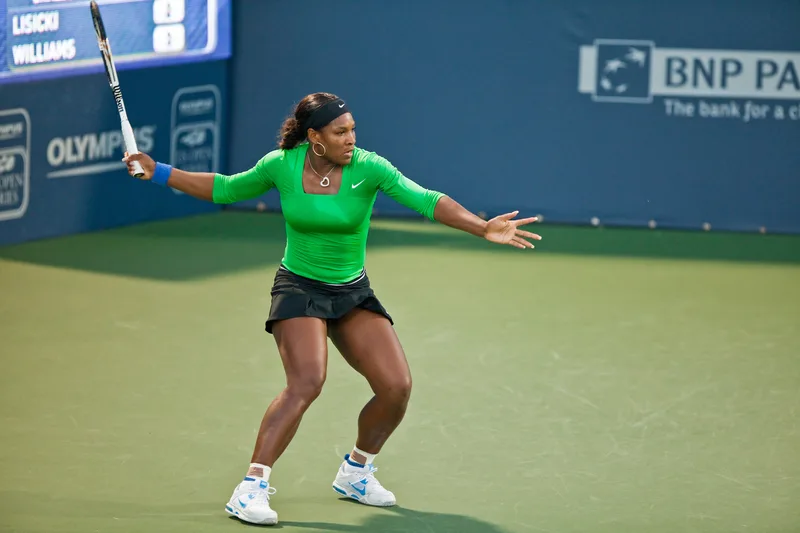
Tennis is better than most other sports regarding equality between men and women. Professional tennis players receive equal pay regardless of their gender, for example.
They play with the same racquets and on the same size courts. But despite this, there are still a few differences between men’s and women’s tennis.
The main differences between men’s and women’s tennis:
- Some matches are shorter in women’s tennis
- Women sometimes play with faster balls
- Men and women have different dress codes
- Men generally score more aces
- Men and women have different governing bodies
1. Some Matches Are Shorter In Women’s Tennis

In most tournaments, there are no differences between how long men and women play. The standard is a best-of-three format, meaning players play up to three matches to determine a winner.
However, the four Grand Slam tournaments are exceptions. In Wimbledon, the French Open, the Australian Open, and the US Open, men play in a best-of-five format, while women still play best-of-three.
The official reason for the difference is that men tend to serve faster balls than women due to physiological differences. The faster serves make the game go faster, and the best-of-five system aims to increase match lengths so that a women’s and men’s tennis match will last more or less the same amount of time.
However, the rule isn’t without its controversies, and many people feel that men should also play best of three.
2. Women Sometimes Play With Faster Balls

There are no differences between the equipment men and women use while playing tennis. Not even the lines on the courts are different. But there is one exception in only one major tournament: the US Open.
The US Open requires women to use different balls from men. The ones used in men’s matches have a thicker, fuzzier felt texture than those used by women. The balls are identical in every other way, but those used in women’s matches are more streamlined, allowing for faster play and easier shots.
Though there are doubts about its origin, the Women’s Tennis Association says that they introduced the rule in the 1980s because women’s tennis players complained that the regular balls were too hard on their arms.
However, many women’s tennis players are complaining about the balls, stating that they have control issues and aren’t available worldwide, making it challenging to practice with them.
Others, like Madison Keys, like the balls, but these are few and far between. The Women’s Tennis Association consistently monitors the complaints and will consider a possible switch to the same balls men use.
3. Men & Women Have Different Dress Codes

Tennis clothes should be comfortable and allow a great range of motion. In the past, men wore long pants, and women wore ankle-length dresses while playing tennis.
Those days have passed, and modern tennis players have much more freedom in choosing their outfits. Some rules still apply, though, and some are different for men and women.
Men play tennis in shorts, while women play in skirts or dresses. Very few tournaments strictly enforce this rule, but perhaps the most well-known tournaments, the Grand Slams, still hold to it, some more than others.
Some people have the opinion that it is disrespectful to the game for a woman to wear shorts or for men to wear skirts, for that matter. Especially in Wimbledon, the powers still strictly enforce the rule about men wearing shorts and women wearing skirts, along with other rules, such as that all clothing (including underwear) must be white.
Many of the women’s tennis clothing rules are vague, though. For example, the rules state that women must wear suitable tennis attire. But what is suitable tennis attire, and who decides that? Because of these vague rules, some women have begun to push the limits.
A notable example is Serena Williams, who, in the 2018 French Open at Roland Garros, wore a very athletic-looking outfit that would allow plenty of motion and be perfect for playing tennis. Unfortunately, Serena’s outfit offended some of the officials at Roland Garros, who saw it as “unsuitable for tennis” and an “insult to the sport.”
In tennis, men are often complimented for their choices of outfits. It is often the opposite for women; sadly, they are offered far less freedom.
4. Men Generally Score More Aces

It doesn’t take much research to see that men score more aces in tennis than women. In fact, on a list of the most aces scored in tennis in recent years, only one of the ten names is a woman, Kristyna Pliskova, who scored 31 aces in a single match.
This is an impressive feat by all standards. However, compared to the lowest male tennis player in the top ten list (Roger Federer, with 50 aces), it simply emphasizes the point.
This phenomenon is likely due to physiological differences between men and women. It is generally accepted that men have faster serve speeds than women, as mentioned before. Faster shots automatically mean you have a better chance of scoring an ace.
As athletes improve, there’s a strong possibility that this fact could change over time, but for now, it’s hard to ignore the evidence.
5. Men & Women Have Different Governing Bodies

Tennis is regulated internationally by the ITF (International Tennis Federation). The ITF is not concerned about gender-related issues and governs the sport on a broad level.
The broad level includes regulating non-professional tennis matches, rules, and scores. However, on the professional level, men’s and women’s tennis have separate governing bodies.
The ATP (Association of Tennis Professionals) oversees men’s professional tennis. It started operations in 1972, and its primary purpose is to organize men’s tennis tournaments, develop rules and regulations, and handling grievances within the realm of men’s tennis.
Unlike the ITF, the ATP is purely focused on professional players, though its sanctions also spread through the lower ranks.
In response to the ATP, 1973 saw the arrival of the WTA (Women’s Tennis Association). Unlike the ATP, the WTA doesn’t concern itself too much with rules and regulations, except for representing women’s tennis when taking grievances to the ITF.
The WTA focuses on organizing and planning tennis tournaments for women, but only on a professional level.
Both organizations work closely with the ITF to ensure that their representative groups are well-represented in the world of professional tennis.
The organizers of particular events, like the French Federation of Tennis, which organizes the French Open with the ITF, have their own rules regarding differences between men’s and women’s matches.
The ATP and WTA are responsible for ensuring that their players keep to the rules as stipulated by these smaller, local organizations while also representing their players’ rights.
